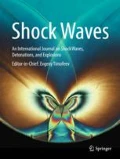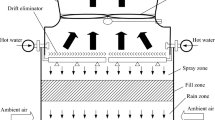Abstract
In this paper, blast mitigation using water mist was evaluated to assess the operational capability of the use of firefighting systems implemented in ships or infrastructures to reduce blast effects. In particular, we tried to determine the mitigation that could be obtained in specific situations. A tunnel equipped with a water mist system enabled us to assess the mitigation impact of water mist on a blast. Blast effects were evaluated using four pressure gauges on the tunnel walls and one pressure gauge at the end of the tunnel. As a first step, we evaluated the mitigation efficiency based on water mist characteristics (the droplet size and the water load) when the charge was detonated inside the mist, the tunnel being either open or closed. Then, we assessed the mitigation efficiency when the charge was detonated outside the mist with only the blast wave propagated in the mist. The reduction in the initial overpressure and the maximum impulse were higher when the charge exploded inside the water mist, and this is most likely due to the quenching of secondary reactions by the water mist. To obtain a better understanding of mitigation mechanisms, shock tube experiments were conducted. The break-up of water drops in the high-speed airstream behind the shock wave was observed, but the presence of mist had no significant effect on the shock wave profile. This is in line with the importance of fireball extinguishment in the mitigation process.









Similar content being viewed by others
References
Buzukov, A.A.: Decreasing the parameters of an air shock wave using an air–water curtain. Combust. Explos. Shock Waves 36, 395–404 (2000). https://doi.org/10.1007/BF02699393
Pitiot, F., Chabin, P., Desailly, D.: Blast wave mitigation by water: full scale tests and numerical modelling. 29th DDESB Explosives Safety Seminar, New Orleans, LA, USA (2000)
Forsen, R., Carlberg, A., Eriksson, S.: Small scale tests on mitigation effects of water in a model of the Klotz Club Installation in Alvdalen. 27th DoD Explosives Safety Seminar, Las Vegas, NV, USA (1996)
Chen, L., Zhang, L., Fang, Q., Mao, Y.-M.: Performance based investigation on the construction of anti-blast water wall. Int. J. Impact Eng 81, 17–33 (2015). https://doi.org/10.1016/j.ijimpeng.2015.03.003
Jones, A., Thomas, G.O.: On the action of water sprays on fires and explosions: a review of experimental work. Process Saf. Environ Prot., IChemE 71, 41–49 (1993)
Tam, V.H.Y., O’Connell, M., Pedersen, G., Renwick, P.: Testing of the Micromist device: an active soft barrier for explosion control. J. Loss Prev. Process Ind. 16, 81–88 (2003). https://doi.org/10.1016/S0950-4230(02)00024-4
Thomas, G.O.: On the conditions required for explosion mitigation by water sprays. Process Saf. Environ Prot., IChemE 78, 339–354 (2000). https://doi.org/10.1205/095758200530862
Catlin, C.A., Gregory, C.A.J., Johnson, D.M., Walker, D.G.: Explosion mitigation in offshore modules by general area deluge. Process Saf. Environ Prot., IChemE 71, 101–111 (1993)
Bailey, J.L., Farley, J.P., Williams, F.W., Lindsay M.S., Schwer D.A.: Blast mitigation using water mist. NRL report, NRL/MR/6180-06-8933 (2006) https://apps.dtic.mil/dtic/tr/fulltext/u2/a443885.pdf
Resnyansky, A.D., Delaney, T.G.: Experimental study of blast mitigation in a water mist. DSTO report, DSTO-TR-1944 (2006) http://dspace.dsto.defence.gov.au/dspace/bitstream/1947/4562/1/DSTO-TR-1944.PR.pdf
Willauer, H.D., Ananth, R., Farley, J.P., Williams, F.W.: Mitigation of TNT and Destex explosion effects using water mist. J. Hazard. Mater. 165, 1068–1073 (2009). https://doi.org/10.1016/j.jhazmat.2008.10.130
Willauer, H.D., Ananth, R., Farley, J.P., Williams, F.W., Back, G.G., Kennedy, M.C., O’Connor J., Gameiro V.M.: Blast mitigation using water mist: Test series II. NRL report, NRL/MR/6180-09-9182 (2009)
Ananth, R., Willauer, H.D., Farley, J.P., Williams, F.W.: Effects of fine water mist on a confined blast. Fire Technol. 48, 641–675 (2012). https://doi.org/10.1007/s10694-010-0156-y
Tosello, R., Leriche, D., Chauvin, A., Zerbib, J., Jourdan, G., Daniel, E., Mariani, C., Houas, L., Biamino, L.: Shock wave attenuation using water mist. Abstracts of the 22nd Symposium on Military Aspects of Blast and Shock, Bourges, France (2012). https://www.mabs.ch/spiez-base/mabs-21-to-25/mabs-22/
Mataradze, E., Krauthammer, T., Chikhradze, N., Chagelishvili, E.: Shock energy absorber for protection of underground structure from internal explosions. 15th International Symposium on Interaction of the Effects of Munitions with Structures, Postdam, Germany (2013)
Schwer, D.A., Kailasanath, K.: Blast mitigation by water mist (3) Mitigation of confined and unconfined blasts. NRL report, NRL/MR/6410-06-8976 (2006). https://apps.dtic.mil/dtic/tr/fulltext/u2/a452669.pdf
Breda, C., Kerampran S., Sturtzer, M.-O., Arrigoni, M., Legendre, J.F.: Analysis of planar and spherical shock-wave mitigation by wet aqueous foams. In: Kontis, K. (Ed.) Shock Wave Interactions, Selected Articles from the 22nd International Shock Interaction Symposium, University of Glasgow, United Kingdom, 4–8 July 2016, pp. 279–297. Springer International Publishing, Cham (2018). https://doi.org/10.1007/978-3-319-73180-3
Del Prete, E., Chinnayya, A., Domergue, L., Hadjadj, A., Haas, J.-F.: Blast wave mitigation by dry aqueous foams. Shock Waves 23, 39–53 (2013). https://doi.org/10.1007/s00193-012-0400-0
Schwer, D.A., Kailasanath, K.: Numerical simulations of the mitigation of unconfined explosions using water mist. Proc. Combust. Inst. 31, 2361–2369 (2007). https://doi.org/10.1016/j.proci.2006.07.145
Gebbeken, N., Rüdiger, L., Warnstedt, P.: Explosion mitigation by water mist-ring mesh with water curtain. Abstracts of the 25th Symposium on Military Aspects of Blast and Shock, The Hague, The Netherlands (2018). https://www.mabs.ch/spiez-base/mabs-21-to-25/mabs-25/
Schunck, T., Bastide, M., Eckenfels, D., Legendre, J.-F.: Explosion mitigation by metal grid with water curtain. Proc. of the 32nd International Symposium on Shock Waves (ISSW32), Research Publishing, Singapore, pp. 1629–1647 (2019). https://doi.org/10.3850/978-981-11-2730-4_0237-cd
Acknowledgements
We thank our colleagues Thierry Ottié and Eric Schmitt who assisted us in our research by providing technical support.
Author information
Authors and Affiliations
Corresponding author
Ethics declarations
Conflict of interest
The authors declare that they have no conflict of interest.
Additional information
Communicated by D. Frost.
Publisher's Note
Springer Nature remains neutral with regard to jurisdictional claims in published maps and institutional affiliations.
Electronic supplementary material
Below is the link to the electronic supplementary material.
Rights and permissions
About this article
Cite this article
Schunck, T., Bastide, M., Eckenfels, D. et al. Blast mitigation by water mist: the effect of the detonation configuration. Shock Waves 30, 629–644 (2020). https://doi.org/10.1007/s00193-020-00960-1
Received:
Revised:
Accepted:
Published:
Issue Date:
DOI: https://doi.org/10.1007/s00193-020-00960-1




